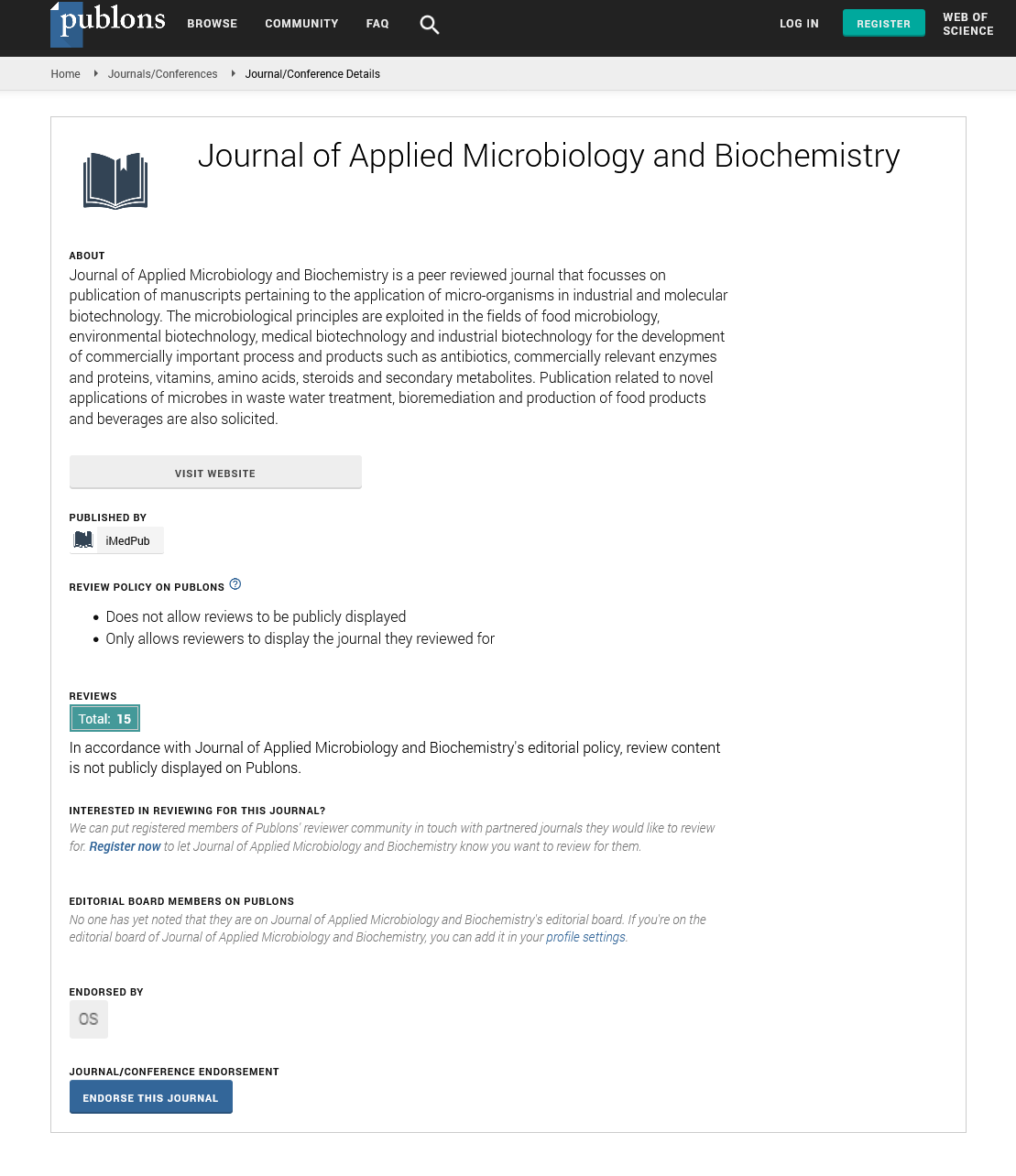ISSN : ISSN: 2576-1412
Journal of Applied Microbiology and Biochemistry
Abstract
Applied Microbiology 2016- Extraction and purification of biochemical molecules from thermophilic Bacillus species- Khalid Fandi - University of Tabuk
Bacteria are ubiquitous and highly diverse. They will survive altogether kinds of inhospitable environments. The hot springs are very rich in thermophilic microorganisms that are capable to produce thermostable enzymes and biological compunds obtained by organic solvent were subjected to silica gel, Sephadex LH-20, RP18 column chromatography and preparative PTLC for further purification. Several indole derivatives are isolated from these selected strains, namely 1-acetyl-β-carboline, tryptophol, and indole-3-carboxylic acid. This is the first report on biochemical compounds profile purified from thermophilic bacteria and other strains showed interesting activities also as different UV absorbing bands on TLC. Therefore, the performing on these strains might be promising to isolate active new metabolites.
Studies within the last 20 years have revealed that 99% of bacteria present within the environment are still unexplored or overlooked in laboratory cultivation and hence remain obscure for his or her ecological functions and unexploited for biotechnological applications (1). Thermophilic bacteria are microbes that mostly inhabit hot springs, live and survive in temperatures above 70°C. they need been less explored thanks to difficulties in isolation and maintenance of pure culture. Therefore, their diversity and biotechnological potential remains to explored from majority of the thermal habitats. As a consequence of growth at high temperatures and unique macromolecular properties, thermophiles can possess high metabolism, physically and chemically stable enzymes and lower growth but higher outcome yields than similar mesophilic species .
Thermophilic microorganisms have gained world-wide importance thanks to their tremendous potential to supply thermostable enzymes that have wide applications in pharmaceuticals and industries (3). Proteases are such enzymes which account for nearly 60% of the entire world-wide enzyme sales (4). Thermostable proteases are of greater advantage in applications because they not only don't usually denature at high temperatures, but they also remain active at such temperatures. Several workers have reported thermophilic bacteria from diverse environmental habitats like geothermal sites and hot springs. The state of Odisha, situated in eastern region of India, is additionally rich in hot springs. One such thermal spring is Tarabalo. The microbial diversity of this thermal spring has not yet been fully studied, but there are few sporadic reports by Rath et al. Therefore, the aims of this study were to isolate thermophilic bacteria from muddy soil samples of Tarabalo hot springs, determine the thermostability of the isolates, screen for industrial enzymes and study the phylogenetic affiliation of the thermophilic bacterium as compared with other bacterial isolates occurring as mesophiles, thermophiles and hyperthermophiles.
MATERIALS AND METHODS
Study site & collection of samples
The hot spring Tarabalo is situated at the district of Nayagarh, Odisha, India. it's the second largest thermal spring of India, as per the report of Tourism Development Corporation India. Tarabalo thermal spring is situated at 20° 14’ 49.38” E Longitude and 85° 19’ 11.04”N Latitude. Before exploration the place was a paddy. Thanks to its remoteness it's less influence by human interferences and believed to possess rich microbial wealth. The temperature of the recent spring during the sampling period was about 60°C. The pH was recorded to be within the range of 8-9 indicating alkaline environment. Samples (muddy soil) were collected from different sites of the recent spring in sterile poly bags and immediately brought into the laboratory.
Isolation of bacteria
Bacteria were isolated in agar (NA) medium (Himedia, Mumbai) India following serial dilution technique. The procedure adopted was as follows: 10 gram of soil sample was diluted in 90 ml of sterile water in 250 ml conical flask and kept it a orbital shaker at 150 rpm to urge a homogenized soil suspension. Serial dilution was made and dilution of 10−7 was inoculated into NA plates and incubated at 37°C for twenty-four h. Isolated colonies growing on each diluted plates were transferred into freshly prepared agar slants. The bacterial strains isolated on NA slants were kept at in refrigerator for further study.
Determination for thermo-tolerance
Pure cultures of the bacterial isolates were determined for his or her thermophilic characteristics. Each bacterial isolates were inoculated into 5 ml of nutrient broth medium in test tubes. The tubes were incubated at initial temperature of 50°C for 12 h. After specified time period each broth culture of bacteria were streaked onto freshly prepared agar medium. Bacterial isolates growing within the plates were selected and again tested for his or her thermo-tolerance at higher temperature. Finally a bacterium that would tolerate temperature of 90°C was selected for further study.
Identification and characterization of the isolate
The selected strain was observed morphologically and growth characteristics were studied. The isolate was characterized by Gram staining technique. supported Gram's staining the strain was found to be Gram-positive and microscopic observation revealed rod shaped bacterium arranged in chain. Various biochemical tests like endospore formation, motility, anaerobic; catalase and oxidase tests were performed. Morphological, microscopic observation and biochemical test indicated the bacterium to be Bacillus sp.
Note- This work is partly presented at 3rd World Congress and Expo on Applied Microbiology November 07-09, 2016 Dubai, UAE.
Author(s): Khalid Fandi
Abstract | PDF
Share This Article
Google Scholar citation report
Citations : 342
Journal of Applied Microbiology and Biochemistry received 342 citations as per Google Scholar report
Journal of Applied Microbiology and Biochemistry peer review process verified at publons
Abstracted/Indexed in
- Google Scholar
- China National Knowledge Infrastructure (CNKI)
- Cosmos IF
- Directory of Research Journal Indexing (DRJI)
- Publons
- Secret Search Engine Labs
Open Access Journals
- Aquaculture & Veterinary Science
- Chemistry & Chemical Sciences
- Clinical Sciences
- Engineering
- General Science
- Genetics & Molecular Biology
- Health Care & Nursing
- Immunology & Microbiology
- Materials Science
- Mathematics & Physics
- Medical Sciences
- Neurology & Psychiatry
- Oncology & Cancer Science
- Pharmaceutical Sciences
